Resources for collectors -
Silver and bronze coinage of the Kunindas (ca.2nd-1st century BC)
This page is meant as a
resource for collectors, illustrating and discussing the silver drachms from the
ancient Indian Kingdom of the Kunindas. The coins pictured on this particular
page are not for sale.
If you want to use some of this page or
some of the images - please ask first. Please do not copy the information shown
here and reproduce it elsewhere.
Go back to the "resources
for collectors" page
(Very) brief history of the Kunindas:
The Kingdom of Kuninda (or Kulinda in ancient literature)
is a North-Indian native Kingdom stretching along the foothills of the Hymalayas
eastwards from the borders of Audumbara, Vemaka and Vrishni to the borders of
Nepal. The Greek historian Ptolemy linked the origin of the Kuninda to the country where the rivers Ganges,
Yamuna, and Beas originate.
The history of the kingdom is documented from around the 2nd century
BCE and it was mentioned by the ancient authors, notably in Indian epics and
puranas. The most famous king of the Kunindas was Amoghbhuti, who ruled in the valley of the Jamuna, Beas and Sutlej rivers (in today's Punjab in northern India).
His date is variously dated to the late 2nd century BC or early 1st century AD,
though the exact dates are unknown.
One the Edicts of Ashoka on a pillar is also present at Kalsi, in the region of Garhwal, indicating the spread of Buddhism to the region from the 4th century BCE.
The Kuninda kingdom disappeared around the 3rd century, and from the 4th century, it seems the region shifted to Shaivite beliefs.
The coinage of the Kunindas:
Until the reign of Amoghbhuti it seems that
the coins circulating among the Kunindas were the silver drachms and
tetradrachms of the Indo-Greeks. The first native coins of the Kunindas were
produced during the reign of the King Amoghbhuti (late 2nd century-early 1st
century BC), though some numismatic authorities consider them to be later issues
and date them to ca.20 BC-80 AD. The coins, silver drachms, were influenced by the numismatic model of the neighbouring Indo-Greek kingdoms,
but the design was purely native, incorporating Buddhist symbolism such as the
triratna, deer, Lakshmi, swastika etc. These coins typically follow the Indo-Greek weight and size standards (drachms, of about
2.1 to 2.2 grams in weight and 19 mm in diameter), and their coins are often found together with Indo-Greek coins in hoards, such as those of the Yaudheyas, or the Audumbaras. They represent the first effort by an Indian to produce coins that could compare with those of the
Indo-Greeks.
The coins are among the most beautiful cons
of the early India, in my opinion. The design is complex, resulting in crowded
dies, but it is very attractive, with the full-breasted, wide-hipped Lakshmi
holding a long lotus flower possessing a lot of charge. The bilingual
inscriptions indicating the clash of the Indo-Greek and native cultured just
added to the charm of these coins.
All the silver drachms of the Kunindas are
rare - they rarely make it to the Western market, unsurprisingly, and are not
well-known among collectors, though a few examples appeared recently on CNG and
Spink. The retail price (as of 2007) for the coins of "common" types
varies, but the usual range is 150US$ to 200US$ for coins in VF-EF condition. I
have never seen the coins of rare types (with swastikas, standards or other
symbols on obverse fields) for sale, but I would estimate the retail price for
them to be 200-300$ for coins in VF-EF.
This webpage:
Because of the obscurity of these coins, it
is difficult to find any comprehensive information about them. While all these
silver drachms have similar inscriptions on both sides and an identical design,
the design and location of the control marks on obverse (and a standard on
reverse) can vary. Some types were published previousely - Boppearachchi reports
two types (one of them probably misinterpreted - see catalogue, below),
Mitchiner (Ancient & Classical World) reports five varieties, and most other
catalogues report only one or two varieties. I have listed 18 types, at least 10 of which were never previousely published.
No collector or dealer that I've known put together a collection of these coins,
so I thought creating a webpage listing the unknown and (previousely)
unpublished types would be of help to the collectors of Indian coins. Along with
the pictures of different varieties, the drawings of the symbols for both the
obverse and the reverse are shown, and the relative rarities for the different
types are indicated. If you ever encountered any types not listed here, please
drop me an email - I would love to hear from you.
Corrections for Mitchiner ACW catalogue:
I wanted to list, very briefly, the few
errors appearing in the Mitchiner catalogue in the "Kunindas" section
(not really of much importance, but thought I would mention it)
1. The "two cobras"
symbol appearing above the deer NEVER have a dot between them
2. The "standard"
symbol on the reverse comes in two different varieties (with a straight shaft
and one that splits into two curves).
3. The coins were not struck
to a 2.35 gram standard - the weight of about 20 specimens I weighed ranged from
2.05 grams to 2.31 grams, with most coins (even in an uncalculated condition)
weighing about 2.15-2.20 grams.
4. The Prakrit inscription is
incorrectly transcribed in Mitchiner (letter "h" in "Rajnah"
omitted) (corrected below).
Symbols:
This is the list of some of
the symbols encountered on the silver drachms of the Kunindas.
Catalogue:
Silver Coins:
|
Obverse:
Deer standing right, crowned by two cobras, attended by Lakshmi holding a lotus flower. Legend in Prakrit
(Brahmi script), various marks in fields (see catalogue) |
Prakrit
inscriptions on the obverse:

Rajnah
Kunindasa Amoghabhutisa maharajasa ("Great King Amoghabhuti, of the
Kunindas")
|
|
Reverse:
Stupa surmounted by the Buddhist symbol
triratna, and surrounded by a swastika, a "Y" symbol (standard? - two
different types, see catalogue), and a tree in railing, wavy line (river?)
underneath. Kharoshti legend. |
Karoshti
inscriptions on the reverse:

Rana
Kunindasa Amoghabhutisa maharajasa ("Great King Amoghabhuti, of the
Kunindas")
|
| # |
Picture |
symbols |
Notes |
| Obverse |
Reverse |
|
ACC #1a.1 |
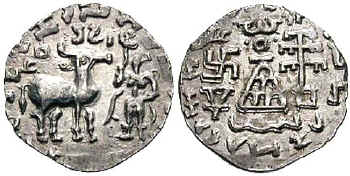 |
 |
 |
The type without any additional marks on
obverse. "Straight shaft standard" on reverse. Comes in both a neat style and a very crude style, thought to be
of later manufacture (?). 18mm, 2.2 grams. Surprisingly rare, published in Mitchiner ACW, but nowhere else, it seems. (Image courtesy CNG).
Mitchiner ACW #4445.
|
|
ACC #1a.2 |
 |
Same as ACC #1.1, but of much cruder style and
smaller, though of slightly heavier than usual weight (17mm, 2.3 grams).
(Image courtesy ACC).
Mitchiner ACW #4445 var.
|
|
ACC #1b |
 |
 |
 |
The type without any additional marks on
obverse. "Split shaft standard" on reverse. 18mm, 2.2 grams. (Image
courtesy ACC).
Completely unpublished, much scarcer than the preceeding type. |
|
ACC #1c |
 |
 |
 |
The type without any additional marks on
obverse with with a "Vase" split in two by a prominent horizontal stroke.
"Straight shaft standard" on reverse. 18mm, 2.2 grams. (Image courtesy
ACC).
Completely unpublished, much scarcer than the preceeding type. |
|
ACC #2 |
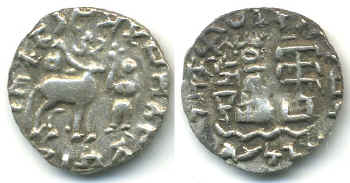 |
 |
 |
Same as ACC #1, with the exception of a dot
between deer's legs. 18mm, 2.2 grams. Unique? The coin pictured is the
only one published or known (?). (Image courtesy ACC).
Unpublished.
|
|
ACC #3 |
 |
 |
 |
Three-arched
hill without a crescent. 18mm, 2.2 grams. Rare. (Image courtesy ACC).
Unpublished, but coins of this type are easily confused with the
similar ACC #4 is not examined closely. They might actually be the same as
the next type, but with an unengraved crescent on top of the hill.
More
pictures of coins of this type (courtesy ACC):
 

***
 (courtesy Hans Sanders)
(courtesy Hans Sanders) |
|
ACC #4 |
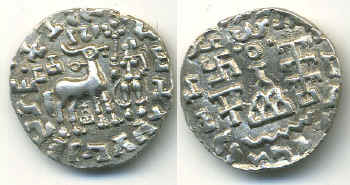 |
 |
 |
Three-arched
hill with a crescent and without any additional symbols. 18mm, 2.2 grams.
Rare. (Image courtesy ACC).
This type is the most "common" type for this issue (although,
please keep in mind, all these coins are still very rare).
They are usually neatly engraved - I have never encountered a very
crude example of this type.
Mitchiner ACW #4440-4441.
More
pictures of coins of this type:
 
 
 
 
 
 

|
|
ACC #5 |
 |
 |
 |
Same as above, with the exception of the
"split" standard on reverse.18mm, 2.3 grams. Unique? The coin
pictured is the only one published or known (?). (Image courtesy ACC).
Unpublished.
|
|
ACC #6 |
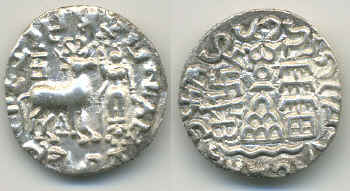 |
 |
 |
Same as above, but with an additional
"lotus" symbol below Lakshmi (within the inscription).18mm, 2.2
grams. Unique? The coin pictured is the only one published or known (?).
(Image courtesy ACC).
Unpublished.
|
|
ACC #16 |
 |
 |
 |
Three-arched hill below the deer and an "apple"
between Lakshmi and deer. Unique? The coin pictured is the only one
published or known (?). (Image courtesy S. Kumar).
Unpublished.
|
|
ACC #7 |
 |
 |

|
Same as above, but with a five-arched hill on
obverse. This type is reported in W.Pieper, Kuninda, #2, the second coin
known is pictured here. (Image courtesy ACC). |
|
ACC #8 |
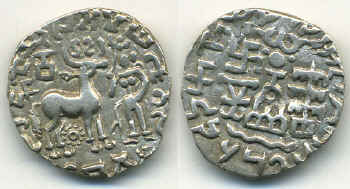 |
 |
 |
With a "lotus" symbol below the
deer.18mm, 2.2 grams. Unique? The coin pictured is the only one published
or known (?). (Image courtesy ACC).
Unpublished.
|
|
ACC #9 |
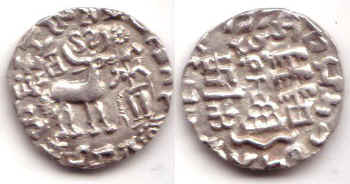 |
 |
 |
With a "lotus" symbol below Lakshmi
(within the inscription).18mm, 2.2 grams. Very rare. (Image courtesy
ACC).
Mitchiner ACW #4443.
More
pictures of coins of this type:
 (courtesy ACC)
(courtesy ACC)
 (Courtesy Hans Sanders)
(Courtesy Hans Sanders) |
|
ACC #10a |
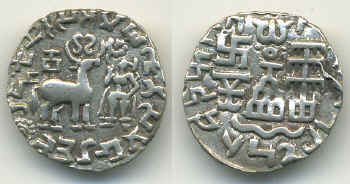 |
 |
 |
With a "lotus" symbol in the left
lower field (within inscriptions) on obverse.18mm, 2.2 grams. Very rare.
(Image courtesy ACC).
Mitchiner ACW #4444.
More
pictures of coins of this type:
 (courtesy ACC)
(courtesy ACC)
 (courtesy Hans Sanders)
(courtesy Hans Sanders) |
|
ACC #10b |
 |
 |
 |
A unique example, sent in by an anonymous
collector. With a "lotus" symbol in the upper central field on obverse and
upper right field on the reverse. |
|
ACC #11 |
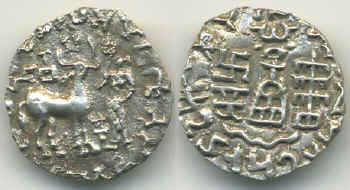 |
 |
 |
With a "standard" symbol between the
deer and Lakshmi.18mm, 2.2 grams. Unique? The coin pictured is the only
one published or known (?). (Image courtesy ACC).
Unpublished.
|
|
ACC #12a |
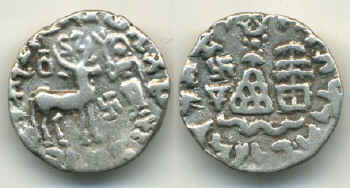 |
 |
 |
With a "swastika" symbol between the
deer and Lakshmi.18mm, 2.2 grams. Unique? The coin pictured is the only
one published or known (?). (Image courtesy ACC).
Unpublished.
|
|
ACC #12b |
 |
 |
 |
With a "swastika" symbol beneath Lakshmi. Unique? The coin pictured is the only
one published or known (?). (Image courtesy Hans Sanders).
Unpublished.
|
|
ACC #13 |
 |
 |
 |
With a "peacock" (or
"chalice") symbol between the deer and Lakshmi.18mm, 2.2 grams.
Extremely rare. The coins pictured are the only ones published or known (?). (Image
courtesy ACC).
Unpublished.
Another similar example (courtesy Hans Sanders):
 |
|
ACC
#14 |
 |
 |
 |
The symbols are reported in Mitchiner ACW
(#4442) as "swastika and three-arched hill". The Swastika is
unambiguous, but the hill is tiny, and unclear on the Mitchiner plate coin
- to me, it looks more like a small peacock (like on the previous type).
18mm, 2.3 grams. Extremely rare type, one of the scarcest in the series.
(Image courtesy ACC).
Published in Mitchiner ACW (#4442).
|
|
ACC #15 |
 |
 |
 |
With swastika under deer, lotus under Lakshi and
a nandipada symbol between the deer and Lakshmi.
Unpublished and very
rare. |
|
ACC #17 |
 |
 |
 |
The obverse is of the common type 1a, but the
reverse has two additional cobras over swastika. I know only of one coin of
this type.
Unpublished and unique. |
Bronze Coins:
Type 1 (early issues?)
The bronze coins of the Kunindas are much cruder than the silver
and are very poorly studied. They come in numerous varieties, but catalogues
usually lump them into one or two entries. I will try to be slightly more
detailed here, though finding good quality pictures of the Kuninda bronzes is
not easy....
The bronzes can be be divided into two general groups. The coins
from the first group are presumably the early issues, since they parallel the
silver coins described above very closely. The design is the same as above, and
the inscriptions are present on both sides - in Brahmi on obverse and in
Kharoshti on reverse:
|
Obverse:
Deer standing right, crowned by two cobras, attended by Lakshmi holding a lotus flower. Legend in Prakrit
(Brahmi script), various marks in fields (see catalogue) |
Prakrit
inscriptions on the obverse:

Rajnah
Kunindasya Amoghabhutisya maharajasya ("Great King Amoghabhuti, of the
Kunindas").
|
|
Reverse:
Stupa surmounted by the Buddhist symbol
triratna, and surrounded by a swastika, a "Y" symbol (standard? - two
different types, see catalogue), and a tree in railing, wavy line (river?)
underneath. Kharoshti legend. |
Karoshti
inscriptions on the reverse:

Rana
Kunindasa Amoghabhutisa maharajasa ("Great King Amoghabhuti, of the
Kunindas").
|
|
|
Obverse design: |
Reverse design: |
Notes: |
|
No photo |
 |
 |
This is probably the rarest of the copper types,
with carefully executed legends on the reverse. I've seen only a few pieces,
all of the same type. The denomination of these is 1/2 karshapana (or a
bronze didrachm) of 4.4 grams or so (40 ratti). Published in Mitchiner ACW (#4446);
Mitchiner 1976 #930-931.
|
Type 2 (later issues?)
|
Obverse:
Deer standing right, crowned by two cobras, attended by Lakshmi holding a lotus flower. Legend in Prakrit
(Brahmi script), various marks in fields (see catalogue below) |
Prakrit
inscriptions on the obverse (ALWAYS very crude):

Rajnah
Kunindasya Amoghabhutisya maharajasya ("Great King Amoghabhuti, of the
Kunindas").
|
|
Reverse:
Stupa surmounted by the Buddhist symbol
triratna, and surrounded by a swastika, a "Y" symbol (standard? - two
different types, see catalogue), and a tree in railing, wavy line
(river?) underneath, legend replaced with a circle of dots. |
No legend
|
***
Go back to the "resources
for collectors" page
 people visited this page since Dec.18th, 2006
people visited this page since Dec.18th, 2006


















































































































